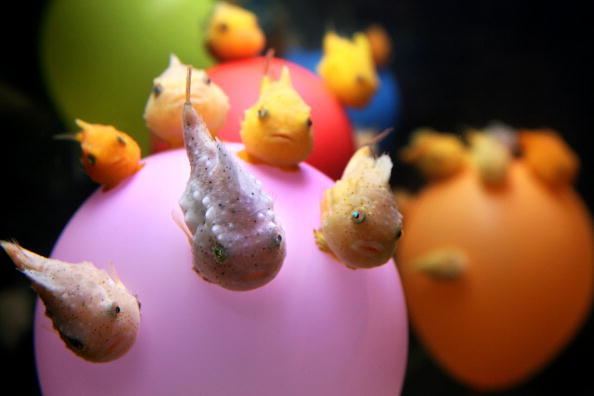Kingdom Animalia Phylum Chordata Rank Family | Scientific name Cyclopteridae Higher classification Scorpaeniformes Order Scorpaeniformes | |
 | ||
Similar Cyclopterus lumpus, Cyclopterus, Scorpaeniformes, Snailfish, Poacher | ||
Curious lumpsucker ponyo fish says hello
Lumpsuckers or lumpfish are mostly small scorpaeniform marine fish of the family Cyclopteridae. They are found in the cold waters of the Arctic, North Atlantic, and North Pacific oceans. The greatest number of species are found in the North Pacific.
Contents
- Curious lumpsucker ponyo fish says hello
- Description
- Habitat and diet
- Behaviour and reproduction
- Fishermen and the lumpsucker industry
- Species
- References
The roe of Cyclopterus lumpus (the lumpsucker or lumpfish to most Europeans and people living along the East Coast of the United States), known as stenbider (literally "stone biter") in Danish, is used extensively in Scandinavian cuisine. The roe is also used as an affordable alternative to the caviar produced by sturgeons.
The family name Cyclopteridae derives from the Greek words κύκλος (kyklos), meaning "circle", and πτέρυξ (pteryx), meaning "wing" or "fin", in reference to the circle-shaped pectoral fins of most of the fish that comprise this family.
Description
Lumpsuckers are named appropriately enough; their portly bodies are nearly spherical with generally drab coloration and lithic patterns. The "sucker" part refers to the fish's modified pelvic fins, which have evolved into adhesive discs (located ventrally, behind the pectoral fins); the fish use these discs to adhere to the substrate. Many species have bony, wart-like tubercles adorning the head and body; these are important taxonomic features of the family.
The simple, rounded fins are small with the exception of the broad, fan-like pectorals, which actually extend ventrally. The first of the two dorsal fins is spinous, with 4-8 spines; in some species, this fin is completely overgrown with skin and therefore not visible. While the lateral line in lumpsuckers is otherwise reduced or absent, it is well developed in the head; some species even have tubular, whisker-like external projections of the opercular canal, which is a part of the cranial lateral line system.
The relatively small mouths of lumpsuckers are lined with narrow rows of small conical teeth. The gas bladder is absent. In terms of length, lumpsuckers range in size from 2 centimetres (0.79 in) in the case of Lethotremus awae up to more than 50 centimetres (1 ft 8 in) in the case of the common lumpsucker Cyclopterus lumpus.
Habitat and diet
As their appearance might suggest, lumpsuckers are poor swimmers. Most species are benthic; that is, they spend most of their time on or near the bottom. The fish are found on rocky or muddy substrates, where their coloration allows for effective camouflage. Members of the family are found primarily on the continental shelf or slope, at depths down to 1,700 metres (5,600 ft). Some of the deeper-living species are however pelagic, remaining some distance above the ocean floor.
Benthic species feed on sessile invertebrates such as polychaete worms, crustaceans and mollusks. Pelagic species target prey they are capable of overtaking, namely slow-moving jellyfish and ctenophores.
Behaviour and reproduction
Lumpsuckers are a poorly studied group, with little known of their behaviour and biology. At least some species are known to travel great distances in order to spawn in shallow, intertidal waters (from December to June in the smooth lumpsucker); this may well be true of all species. Males are also known to guard the brood of spherical eggs.
One of the peculiarities of Lumpsuckers neural system is that they lack Mauthner cell neurons in their hindbrain, while these cells are present in virtually all other teleost fish. Nevertheless, the lumpsuckers do have a C-startle response, which is apparently mediated by other hindbrain cells.
Hatchlings have well-developed pectoral fins and adhesive pelvic discs, which the fish use to cling to rocks in shallow water. Young fish remain in shallow, warmer water until fully developed. Pacific cod and sablefish are known predators of lumpsuckers.
Fishermen and the lumpsucker industry
Cyclopterus lumpus plays an important role in the Icelandic fishing industry; Lotna ehf, a fishing company partly owned by Swansea City midfielder Gylfi Sigurdsson, have recorded catches of lumpfish as large as 2 tonnes. Other fish often caught on trawlers simultaneously with lumpfish include cod.
Species
There are about 30 species in 7 genera:
